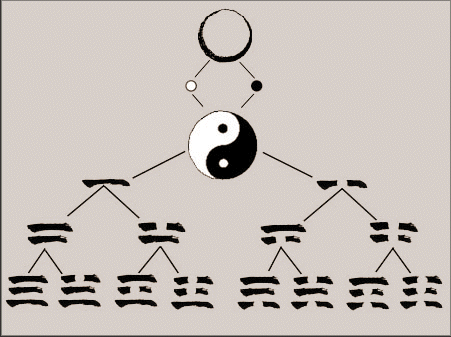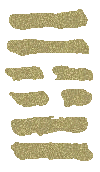Si Xiang (Four Phases)
Fu-Xi’s original concept evolved from the two lines or Yang and Yin into a series of four two line Xiang or symbolic shapes. Placing one line over the other created these. With two lines there are four possible combinations.

The lines represented stages of change between the sky (heaven) and the earth. As shown here the seasons are represented by the changing energy in the lines. Summer is the time of great heat so it is Greater Yang. Spring is Lesser Yin because the heat is beginning to drop off and things have a time of growth. Autumn is Lesser Yang as the earth is now cooling down and things are slowing. Winter is Greater Yin because all is quiet and dormant.
The Evolution of the Yijing Gua
Here is a simple chart to explain the evolution of the eight bases Gua of the Yijing. Fu Xi found that Si Xiang was not enough to fully realize his concept. He added a third line in between each of the two lines of the four phases. The bottom line came to represent the earth the middle line mankind and the upper line the sky or heavens. This was appropriate and was the beginning of the famous Chinese phrase, “Man stands on the earth with his head in the heavens” A phrase that contains the very secrets of Qigong power.


Mr. Li, my Baguazhang teacher, said, “If one knows how to draw the energy of the earth and sky into the body one will become free from illness. He will be as supple as a dragon and strong as a tiger.” This really does not refer to any mystical powers. In the most common understanding it merely means to keep the spine “ridgepole” straight follow the laws of nature and the body will correct itself. That is the core of the art of Qigong and the gate to the connection of Chinese medicine and healing to the Yijing.
From the eight Gua shown here Fu Xi and later contributors of the Yijing began placing one Gua over the other to create 64 possible combinations. These figures of six lines each came to make up the core of the Yijing as it exists today. This is # 61 Zong Fu (inner truth). It shows that between Earth and Heaven is the body and spirit if we have an open mind or hollow center we can come to know the reality of life. The center two Yin lines represent man holding the concept of emptiness surrounded by form. In other words when we are inwardly still we can observe the truth of what is happening.
Taiji Energy Flow in Yijing

From their original form shown above Fu-Xi began to classify each Gua. Over time others added connections that related to each of the Gua. The simple symbols came to represent hundreds of aspects of energy and life both in man, nature, and in the universe.
Before creating the sixty-four arrangements Fu-Xi began to order his Bagua (eight shapes) in a circular configuration placing each of the Yang Gua directly across from the Yin Gua. In this design we can see Earth at the bottom and Heaven at the top. This figure also shows the progression clockwise of the Gua changing from one to the next. It was this figure that was instrumental in creating the familiar Taiji Du diagram many years later.
Here I have colored the Taiji Du Red for Yang and Blue for Yin. The Yang Gua are all red and the Yin, blue. Notice how starting at the bottom the Yin of the Taiji symbol is largest and the Gua of Earth are all Yin. Flowing up to the left side we see the next Gua formed with a single Yang line. The next has two yang lines and so on until we reach the top where the Heaven Gua is a complete Yang energy with the Yang Taiji symbol being the largest and now starting down the first Yin line appears and so on around the circle. This is the correct placement for the Taiji Du symbol as it indicates the energy potential of each Gua.
Each symbol stands for a type of energy found at this point in the eight stages of change. If we examine a Taiji Du placed inside the circle or Pre-heaven arrangement of Fu Xi we can see clearly that each of the Gua represents a slice of energy at one particular point on the circular diagram.